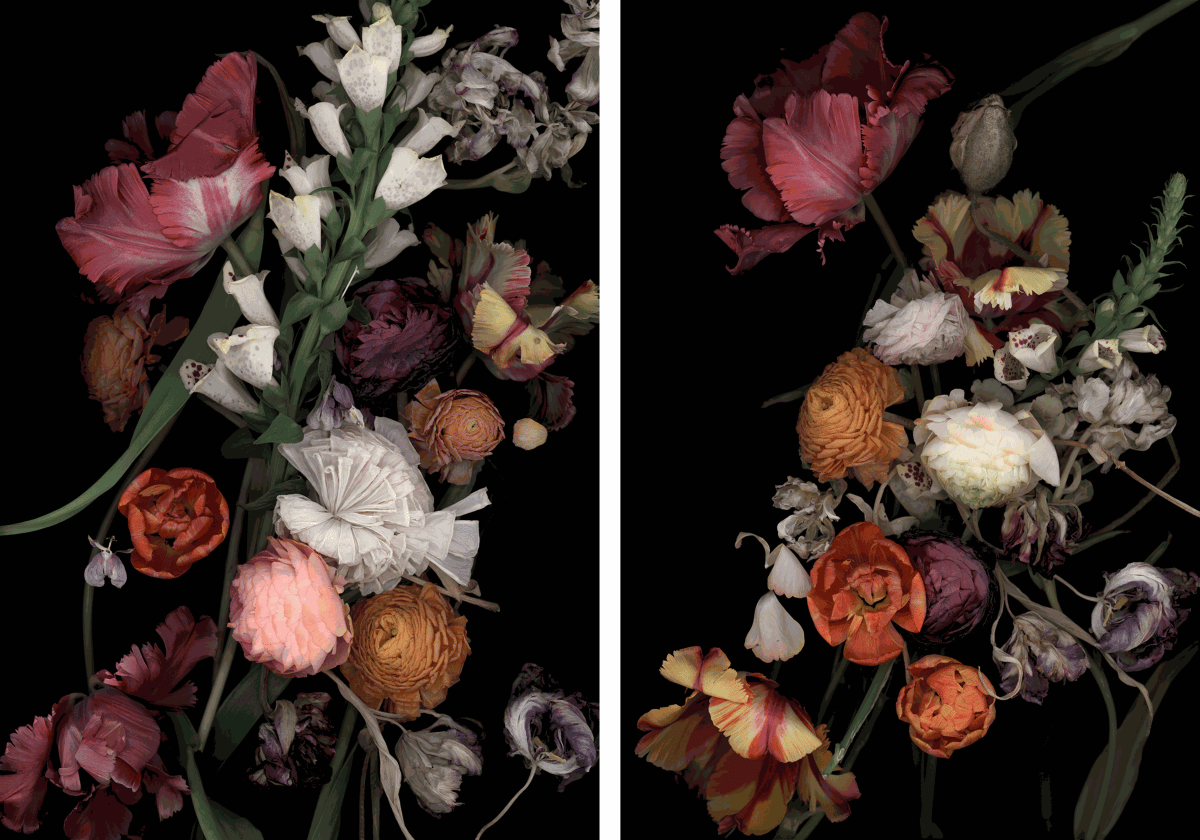Luzia Simons: Stockage and Jardim
The depth of focus is exceptional, the matte blackness of the de-materialized background that emphatically accents the natural objects’ breathtaking plasticity. The tulip blossoms in the large format photographs by Luzia Simons give the impression of being three-dimensional. Even when cut off at the edge of the frame, it appears as if the flowers would lie in display cases or float in a diffuse space without direction, without an above or below. Some are simple compositions, with just a pair of blossoms, while others are more complex, opulent formations of cut flowers with stems and leaves piled atop one another. In their naturalistic reproduction the tulips command an amazing presence. At times they are somewhat unsettling, as their lush figures seem almost to threaten us.
To begin with, the flower belongs to the pollinating species of flowering plants. From a botanical standpoint, the purpose of flowers and blossoms with their blaze of color is to attract pollinators and guarantee reproduction. Butterflies, honeybees, bumblebees, and beetles are meant to land on or climb into them. Thus, many flower photographs are also studies of sexuality. A sensual yet never suggestive component is also latently present in the magnified floral still lifes by Luzia Simons: the bursting flower buds, the carnality of the partially or completely open petals, the erect filaments or flower tubes sprayed with pollen certainly welcome sexual associations. She portrays moments of greatest fertility, which nonetheless remain but a brief instance in the never-ending cycle of life. After every climax follows inevitable decay.
Beyond a mere “art for art’s sake” Luzia Simons showcases her flowers in a unique combination of material accuracy, beauty and vanitas. She deconstructs conventional representations of these motifs, such as floral ornamentation, patterns, or decoration, by elevating them to art. The technique that she uses to do so is equally exceptional. For her tulip arrangements realized under the series title Stockage (French for storage or stockpiling – also in the trading sense) she does not use a camera, but a special scanner with which she can achieve incomparable spatial depth. What makes her scanograms so special is the effect made by the pollen that falls on the scanner’s glass plate: instead of the classical vertical-horizontal picture division, it emphasizes foreground and background, as well as the dark backdrop before which the flowers appear like sculptural forms. As a result, the tulips’ rendering oscillates between extreme closeness and great distance. This is quite different from the two-dimensional photogram that numerous members of the artistic avant-garde simultaneously discovered around 1920, in which the contours of an object placed directly onto photosensitive paper materialize as a shadowlike apparition. In contrast, Simons’ scanograms are fantastic, illusionist spatial images.
In her work, Luzia Simons unites illusionism and naturalism in a very special way. Observing her images, one is overcome by the desire to actually touch the flowers, confirming or even haptically grasping their beauty. To this day, the optical illusion, the trompe l’œil effect of the Renaissance, has not lost its fascination. Situated between herbarium and hortus conclusus, the artist’s tulip presentations reference baroque Dutch or Flemish floral still lifes, evoking images of “tulip mania” and the ruinous trading of tulips and their bulbs in 17th century Holland. To this day, the Netherlands remains the world’s largest tulip producer with more than a thousand common tulip varieties. Fellow photographers turning an artistic lens towards these decorative plants include Irving Penn, who imported Dutch tulips for his floral still lifes in the Christmas issue of Vogue USA in the 1960s, and Rémy Markowitsch, with his contemporary appropriations of flower images from gardening handbooks that recall the history of tulip breeding options named according to countries. For these artists it is the individual flower – with particular emphasis on its color – that becomes a sculptural, indeed, physical phenomenon.
For Simons, the flower as a commodity in the local as well as global market becomes a cultural issue that stands in for the issue of migration – which is one of the central issues the artist addresses in other groups of works as well. The tulip as a motif of a former wild plant native to Asia that has become the object of modern, Western European overbreeding with the most adventuresome illustrations of its petals – as a motif between nature and culture – becomes mere material on the path to an ethereal utopia of beauty. Along their nomadic route from Asia to Europe, tulips become a kind of alter ego for the artist whose own path has taken her from Brazil via France to Germany: Where are the (own) roots, where have they been severed or where have they imbedded themselves anew?
The blossoms lie over one another or are separate. The interaction between several tulips is riveting; they repel one another and then entwine, they look like they are wrestling, or perhaps embracing in harmony. From the myriad of interpretations emerges a theatrical drama that could just as well be staging a ruthless botanical battle over light, water and earth. The opposing pairs of realism and abstraction, light and shadow, the smooth and ragged surfaces serve as the play’s formal structure. Time and space become mere incidentals for what is portrayed and observed; these impress much more through a mesmerizing timelessness, arguably an infinity. In her play with visual spaces and formats, with meaning, perspectives and dimensions, Luzia Simons makes use of an inexhaustible repertoire, a floral universe.
The exibition text is an abbreviated version of an essay by Matthias Harder – Mysterious, Dangerous Beauty
In collaboration with the Brazilian Embassy in Slovenia






